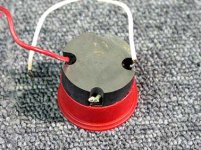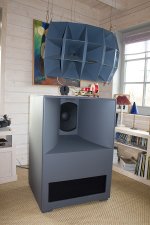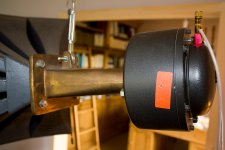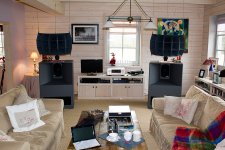I had a pair of Polk SDA 2A's for a while and they they could place sounds behind you. IIRC they worked by simulating ambiophonics by reversing the phase of the right speaker's output and sending it to a dedicated driver on the left speaker, and vice versa.
I though recording engineers could do ambiophonics in a recording with a bit of reverse phase in the opposite channel trickery.
Please understand I'm not saying you or djn are wrong, I'm just having trouble getting my head around this. Listening to cone and dome speakers in the near field, with their wide dispersion, doesn't give that ambiophonics effect, so why do the 1505s? Is it the difference between 180 deg dispersion (cones and domes) and the 100x60? of the 1505s? 😕
Can you elaborate on this? Why cross them at 3Khz, and what do you mean by colorful? What is it about a large room that negates this? Does lobbing become less of an issue at greater listening distances?
Sorry for the barrage of question, I'm just very curious about all this. 🙂
Correct.
Dunno. There's a long, on-going ambiophonics thread here, so do a speaker forums search and ask them.
Much increased directivity and horn 'throw' which extends the near-field much further than a point source system. Remember, true near-field for a 'full-range' point source means having your nose buried in the dust cap. Obviously, this isn't practical to even test, so an easy way to get an idea of ambiophonics's 'headphone' effect is to stand between the speakers with your ears ~on the driver's motor plane.
It's also a good way to find a ~true center position between channels, just use mono and adjust the balance control or amp gain controls to center the signal between your eyes.
Point source drivers, horns are good for ~ a decade (~3.32 octaves), so 300 - 3 kHz, etc.. Remember, when you see a compression horn with wide BW, it's only on axis where it has a rising response due to boundary conditions back at the throat and why the initial expansion is so critical to the horn's HF response and no doubt why the pioneers of audio chose to build it into the driver. The horn itself is unloading all the while, at most, acting as a WG and ultimately as an acoustic HF choke as the mouth impedance effectively increases with increasing frequency.
'Colorful' = euphonic harmonic distortion.
The greater the distance, the lower the acoustic power due to the perceived size of the horn has diminished to where all the individual cells eventually blend into a single focused point source. It's ~ like looking at a regular CRT TV. Up close, you see all the scan lines and the picture is diffuse from all these individual images, but move back far enough and the lines 'disappear' and the picture becomes coherent, sharp. If you can't sit back far enough, then you need a smaller TV screen.
Some folk's hearing (me for one) is such that they need to sit either further away or make the horn smaller or at least XO it lower, so it acts as an acoustic backdrop to a smaller horn that will give us the coherent, sharp acoustic 'picture' if the system is properly time/phase aligned.
Otherwise, ignoring any recording 3D effects, it will sound 3D, though depending where/how it's off, the 3D effect can be wildly distorted, so add in any recording 3D effects and they will comb filter, further distorting the sound-staging. Add in any room early reflections and reverberation and you can wind up with a surreal spatial nightmare.
No need to apologize, they're good Qs on stuff that most folks have a hard time 'wrapping their mind around'. Hopefully my simple minded way of understanding them has helped.
GM
Well added some 1" foam around horn same as i have inside cab for damping, seems to sound better, worked with the eq some more too, here's where i have it now, need to send that other driver in yet too
Hard for me to see dark pictures on this monitor, but it looks like you need a big gasket strip across the bottom of the horn same as the top.
The EQ looks good though, it ~mirrors a CD horn EQ filter's response now.
GM
Hard for me to see dark pictures on this monitor, but it looks like you need a big gasket strip across the bottom of the horn same as the top.
The EQ looks good though, it ~mirrors a CD horn EQ filter's response now.
GM
Thanks GM!. Yea I was thinking about putting one under there too, Just didn't know if it would hold being the horn is concave and it would only be sticking to the flange part of the horn, and with the breeze that comes out that port it may come off,lol.. I will try it tho. Yes After more eqing yesterday I am able to now sit at my location which is about 15 feet away from them at full power and not have that in your face horn sound now!.. Just flat out bass and great vocals
Altec 3000H question.
What is the heavy white coiled wire in the Alec 3000H driver does?
It's seemingly not connected to anything, nor is shorted, just coiled in magnet there.
My other question is, how is the driver secured in place in the base of the horn?
Thanks, Miklos
What is the heavy white coiled wire in the Alec 3000H driver does?
It's seemingly not connected to anything, nor is shorted, just coiled in magnet there.
My other question is, how is the driver secured in place in the base of the horn?
Thanks, Miklos
Attachments
Last edited:
Of course they are, just visualize a small 'full-range' driver at the entrance of each cell. It's a cheap way to make a shallow multi-cell. 😉 Bozak used it to good effect to make (8) cell tweeter 'horns' for the original B310 Concert Grands.
This is an oversimplification of course since the individual cell's design, ergo wall angle affects it, but it's close enough to make a point once beaming begins in earnest.
Thanks for confirming GM, that's pretty much how I was visualizing it.
Cells, like drivers begin beaming when they're ~ 1 WL across, so an 8.5" square cell is at ~160 deg around 1595 Hz, so I'm thinking this 1/2 WL rule pertains to something else.[/QUOTE]
So the size of a horns mouth determines when beaming starts? Or have I miss understood. The manta ray horns, say MR-64's, don't beam at all and they have a huge mouth relative to a single multicell cell.
Or does that rule only apply to certain horn flairs and/or multicell configurations? Do constant directivity designs get around this somehow?
Again, folks like what they like. Me, I either want to XO up really high where none of us have any hearing acuity (just adds top end 'air') or down where the driver (horn) has collapsed to whatever polar response I want. This makes the tweeter horn large enough to mate well with the larger horn before beaming becomes an audible issue.
GM
Yes, least I give anyone the wrong impression I love the sound of the 1003's (300-7.2Khz LR 24 slopes), but the engineer in me just can't leave well enough alone. The more I learn about speaker building, the more short comings I see with what I have, at least from a technical perspective. Also using a digital crossover, makes one wont to experiment. 😛
At some point I guess I have to gather some real data, make sure the polars match at the x-over point etc. Lot of things to improve, or at least experiment with.
Much increased directivity and horn 'throw' which extends the near-field much further than a point source system. Remember, true near-field for a 'full-range' point source means having your nose buried in the dust cap.
Ah, I didn't know that, thanks. Last night I was thinking this over and realized that direct radiators, while having wide dispersion, don't have constant directivity like multicells. Which is why you're saying you need to be very close to be in the near field for direct radiators? Well, that and the fact that their dispersion is too broad to eliminate early reflections.
Point source drivers, horns are good for ~ a decade (~3.32 octaves), so 300 - 3 kHz, etc.. Remember, when you see a compression horn with wide BW, it's only on axis where it has a rising response due to boundary conditions back at the throat and why the initial expansion is so critical to the horn's HF response and no doubt why the pioneers of audio chose to build it into the driver. The horn itself is unloading all the while, at most, acting as a WG and ultimately as an acoustic HF choke as the mouth impedance effectively increases with increasing frequency.
Got it thanks. So does that mean we can state that the multicells don't beam below 3Khz? Which is not to say that they start beaming immediately above 3Khz, but rather that if you cross around 3Khz, beaming between individual cells should not be an issue.
The greater the distance, the lower the acoustic power due to the perceived size of the horn has diminished to where all the individual cells eventually blend into a single focused point source.
So the comb filtering, present in multicells, isn't an issue at large listening distances?
Some folk's hearing (me for one) is such that they need to sit either further away or make the horn smaller or at least XO it lower, so it acts as an acoustic backdrop to a smaller horn that will give us the coherent, sharp acoustic 'picture' if the system is properly time/phase aligned.
I'm using a Gauss 1502 built HF horn (90 deg conical) above 7.2Khz. Now you've got me thinking I should try crossing to a 511 horn below 3Khz. But as you mentioned in your other post, we need to (1) match polars at the x-over point and (2) avoid comb filtering between these two horns by observing the 2c2 1/2 wavelength rule. That might not give me much room to work with, since the wavelength at 3Khz is 4.5".
Arrggg where that thread on Synergy horns.... 😀
No need to apologize, they're good Qs on stuff that most folks have a hard time 'wrapping their mind around'. Hopefully my simple minded way of understanding them has helped.
GM
Thanks GM, I really learn a lot from your posts. You know your stuff and do a good job of explaining it to others.

Funny. This reminds me of once when I was running Altec 811 horns on top of open baffle woofers. Seems I had gotten the polarity reversed on the horns without knowing. Wow! What an effect.
Since the windows in house were always open the soundstage went right outside, there was a trumpet player hiding in the bougainvillea out the window on the right, a snare drum in the hall, guitars in the kitchen. But my neighbors in the house behind would not shut up. Kept mumbling, grumbling about something. Until I realized it was not the neighbors but the piano player! Probably Keith Jarrett 😉. Really sounding like he was out the window 30' behind me at the neighbor's house.
As fun as that all was, it sure killed normal vocals recorded right in the center. So the wiring got put back "right".
Ha, that must have had you guessing for a while. FWIW I was impressed at how well the SDA's kept their center image. It was a lot less gimmicky than I though it would be.
That's interesting. Are you running the E's with an adaptor and a 1" driver? Like GM, I would have thought the B would sound better in that case.
I'm talking about the ring & horn honk between the B & E it's not present or as noticeable to my ears on the E. Especially on the pairs that I have that have the real thick Aquaplas on them.I prefer the E's.They sound real nice Steve Mac can tell you the 511E's are a real nice compact horn for the large format.
They sound just as good with the 802G's w/attachment
( I hate everything Altec , WE and Westrex )
 That suits me fine ! We can keep more of it here in the USA.😀 But here you are in an Altec Lansing thread !!!! 😀
That suits me fine ! We can keep more of it here in the USA.😀 But here you are in an Altec Lansing thread !!!! 😀
Last edited:
Don't mind about Zen Mod (Choky). He's what the plains Indians used to call a Heyoka (Heyókȟao)
Contrary (social role) - Wikipedia, the free encyclopedia
Contrary (social role) - Wikipedia, the free encyclopedia
Don't mind about Zen Mod (Choky). He's what the plains Indians used to call a Heyoka (Heyókȟao)
Contrary (social role) - Wikipedia, the free encyclopedia
Hear Hear !!! 😉
Just joshing ! Everyone is entitled to their opinion, no matter how skewed .



Last edited:
I hate bugatti, maserati and ferrari and all those rich f...ckers who can afford it ;o)
and on the topic , from my limited exposure 288c sounds better crossed over 800hz , below it sounds thin, 511B is perfect for electric guitar music with 'electrifying" presence while with classical sounds like farting mice , 803A is a best horn midbass woofer I've heard with "out of this world" tone.
and on the topic , from my limited exposure 288c sounds better crossed over 800hz , below it sounds thin, 511B is perfect for electric guitar music with 'electrifying" presence while with classical sounds like farting mice , 803A is a best horn midbass woofer I've heard with "out of this world" tone.
Stripped brass throats look great too - beautiful speakers all round.
What's with deal with the lip on the bass horn throat? Haven't seen that before.
What's with deal with the lip on the bass horn throat? Haven't seen that before.
I am jealous.
Says the man with the uber rare 1804's.
So Cal, what did you do with those those beauties? I haven't seen a pic of a completed speaker 🙂.
They are hanging in my speaker room, yet to be fully appreciated. When I have a bigger living area...
They are hanging in my speaker room, yet to be fully appreciated. When I have a bigger living area...
Roger that. Those tar filled 1003's of mine cluttered up our living space for about 18 months, while we were saving for a bigger house.
I like the flying horns. I am jealous.
Me too, if you ever feel the need to get rid of them please contact me ASAP
 😀
😀Me too, if you ever feel the need to get rid of them please contact me ASAP😀
In fact, the reason for the flying horn is that I wanted to have flexibility for the time alignment. Finally, I decided to keep tehm hanging as my wife like this solution...
Before the 825, I had a supravox 285GMF and before that, ONKEN with 416-8C. Time alignment with the Onken was an issue. I am listening close to the loudspeakers and the stage (3D effect) is much better when these horns are associated with the 825.
- Home
- Loudspeakers
- Multi-Way
- Altec Lansing





